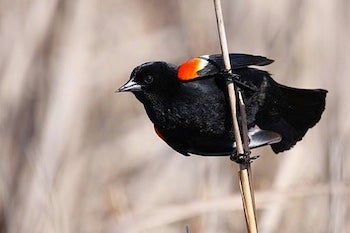
La página que intenta visitar sólo está disponible en inglés. ¡Disculpa!
The page you are about to visit is currently only available in English. Sorry!


Wikimedia Commons
As James Gorman suggested Saturday in a New York Times article, “Mass Animal Deaths: An Environmental Whodunit,” our initial, outlandish speculations about the Arkansas blackbird deaths—dubbed a sign of an “aflockalypse” by some, but actually the result of isolated fireworks—revealed something essential about our nature: an overwhelming urge to understand and attribute. “Our minds have evolved to look for patterns, and causative agents,” Gorman writes. To help explain why, he goes on to describe the parable of early hominids walking the plains of Africa: When our ancestors heard rustling in the grass, the savviest among them thought “lion” first, even if it was just the wind.
Likewise, following the awful shooting in Arizona this weekend, commentators—including the Pima County Sheriff—quickly blamed a nation-wide (and Arizona-intensive) “rhetoric of violence.” This was a glimpse of the coming rhetoralypse, if you will. The left blamed the right for heated, irresponsible words, while the right called out the left for crying lion, and capitalizing on a tragic moment before all the facts were in (i.e., for turning Sarah Palin’s now infamous crosshairs back around). Irrespective of sides, everyone wanted an answer to the larger “whodunit,” and sought a take-home message, ASAP, whether less “rhetoric of violence,” more gun control, or greater attention to mental health issues.
For though the killer, Jared Lee Loughner, planned his attack, not surprisingly he was delusional and, somewhat surprisingly, unaffiliated. The shooting was not partisan, but closer to random (though, by nature, still political). We’re not likely to know why Loughner acted: Some firework went off in his head, probably lit by a chemical imbalance. Yet though there may be no direct link between “rhetoric of violence” and the Tucson tragedy, the toxic political discourse the nation now finds itself discussing isn’t just imagined (and, as everyone's saying, it should be addressed). In a similar fashion, though recent mass wildlife die-offs may be natural and relatively common (not the work of poison, conspiracy, or UFOs), that doesn’t mean the “alflockalypse” has been averted: birds and their habitats are still in trouble.
Consider National Audubon Society President David Yarnold’s take on the blackbird drama in his CNN op-ed last week. “Birds and other wildlife are sending humans a message,” Yarnold wrote, referring to the systemic environmental issues they, and we, confront. “And the public concern about this flock of red-winged blackbirds shows that many people are paying attention. Whatever caused thousands of birds to perish in Arkansas, the warning signals are all around us.” He points out that forty years of Audubon citizen-science shows many bird populations are in a state of decline.
It’s a sobering point, one the unfortunate Arkansas blackbirds gave us an opportunity to think about. It offered up a moment of national reflection and galvanized discussion, as the Tucson tragedy now has in another arena (and on a larger scale). And our speculations and attributions, though perhaps too quick, remain apt: If we don’t react to the wind rustling through the grass, then maybe we risk the lion creeping up through the grass.